Mars sample-return mission
A Mars sample-return (MSR) mission is a proposed mission to collect rock and dust samples on Mars and return them to Earth.[1] Such a mission would allow more extensive analysis than that allowed by onboard sensors.[2]
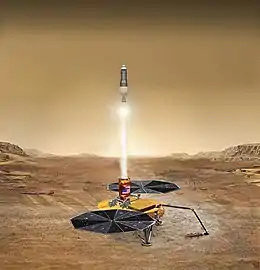
The three most recent concepts are a NASA–ESA proposal, a CNSA proposal, Tianwen-3, and a Roscosmos proposal, Mars-Grunt. Although NASA and ESA's plans to return the samples to Earth are still in the design stage as of 2022, samples have been gathered on Mars by the Perseverance rover.[3]
Risks of cross-contamination of the Earth biosphere from returned Martian samples have been raised, though the risk of this occurring is considered to be extremely low.[4]
Scientific value
.jpg.webp)
Once returned to Earth, stored samples can be studied with the most sophisticated science instruments available. Thomas Zurbuchen, associate administrator for science at NASA Headquarters in Washington, expect such studies to allow several new discoveries at many fields.[5] Samples may be reanalyzed in the future by instruments that do not yet exist.[6]
In 2006, the Mars Exploration Program Analysis Group identified 55 important investigations related to Mars exploration. In 2008, they concluded that about half of the investigations "could be addressed to one degree or another by MSR", making MSR "the single mission that would make the most progress towards the entire list" of investigations. Moreover, it was reported that a significant fraction of the investigations could not be meaningfully advanced without returned samples.[7]
One source of Mars samples is what are thought to be Martian meteorites, which are rocks ejected from Mars that made their way to Earth. As of April 2019, 266 meteorites had been identified as Martian, out of over 61,000 known meteorites.[8] These meteorites are believed to be from Mars because their elemental and isotopic compositions are similar to rocks and atmospheric gases analyzed on Mars.[9]
History
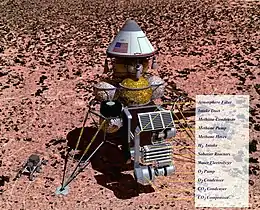
For at least three decades, scientists have advocated the return of geological samples from Mars.[10] One early concept was the Sample Collection for Investigation of Mars (SCIM) proposal, which involved sending a spacecraft in a grazing pass through Mars's upper atmosphere to collect dust and air samples without landing or orbiting.[11]
The Soviet Union considered a Mars sample-return mission, Mars 5NM, in 1975 but it was cancelled due to the repeated failures of the N1 rocket that would have launched it. Another sample-return mission, Mars 5M (Mars-79), planned for 1979, was cancelled due to complexity and technical problems.[12]
In the late 1980's, multiple NASA centers contributed to a proposed Mars Rover Sample Return mission (MRSR).[13][14] As described by JPL authors, one option for MRSR relied on a single launch of a 12-ton package including a Mars orbiter and Earth return vehicle, a 700-kg rover, and a 2.7-ton Mars ascent vehicle which would use pump-fed liquid propulsion for a significant mass saving.[15] A 20-kg sample package on the MAV was to contain 5 kg of Mars soil. A Johnson Space Center author subsequently referred to a launch from Earth in 1998 with a MAV mass in the range 1400 to 1500 kg including a pump-fed first stage and a pressure-fed second stage.[16]
The United States' Mars Exploration Program, formed after Mars Observer's failure in September 1993, supported a Mars sample return.[17] One architecture was proposed by Glenn J. MacPherson in the early 2000s.[18]
In 1996, the possibility of life on Mars was raised when apparent microfossils were thought to have been found in Mars meteorite, ALH84001. This hypothesis was eventually rejected, but led to a renewed interest in a Mars sample return.[19]
As of late 1999, the MSR mission was anticipated to be launched from Earth in 2003 and 2005.[20] Each was to deliver a rover and a Mars ascent vehicle, and a French supplied Mars orbiter with Earth return capability was to be included in 2005. Sample containers orbited by both MAVs were to reach Earth in 2008. This mission concept, considered by NASA's Mars Exploration Program to return samples by 2008,[21] was cancelled following a program review.[22]
In the summer of 2001, the Jet Propulsion Laboratory (JPL) requested mission concepts and proposals from industry-led teams (Boeing, Lockheed Martin, and TRW).[23] The science requirements included at least 500 grams of samples, rover mobility to obtain samples at least 1 kilometer from the landing spot, and drilling to obtain one sample from a depth of 2 meters. That following winter, JPL made similar requests of certain university aerospace engineering departments (MIT and the University of Michigan).
Also in 2001, a separate set of industry studies was done for the Mars ascent vehicle (MAV) due to the uniqueness and key role of the MAV for MSR.[24] Figure 11 in this reference summarized the need for MAV flight testing at a high altitude over Earth, based on Lockheed Martin's analysis that the risk of mission failure is "extremely high" if launch vehicle components are only tested separately.
In 2003, JPL reported that the mission concepts from 2001 had been deemed too costly, which led to the study of a more affordable plan accepted by two groups of scientists, a new MSR Science Steering Group and the Mars Exploration Program Analysis Group (MEPAG).[25] Instead of a rover and deep drilling, a scoop on the lander would dig 20 centimeters deep and place multiple samples together into one container. After five years of technology development, the MAV would be flight-tested twice above Earth before the mission PDR (Preliminary Design Review) in 2009.
In 2004, JPL published an update on the 2003 plan.[26] MSR would use the new large skycrane landing system in development for the Mars Science Laboratory mission (later named Curiosity). A MSR Technology Board was formed, and it was noted that the use of a rover might return to the MSR plan, in light of success with the Spirit and Opportunity rovers that arrived early in 2004. A 285-kg ascent rocket would carry 0.5 kg of samples inside a 5-kg payload, the Orbiting Sample (OS). The MAV would transmit enough telemetry to reconstruct events in case of failure on the way up to Mars orbit.
As of 2005, a rover had returned to the MSR plan, with a rock core drill in light of results from the Mars Exploration Rover discoveries.[27] Focused technology development would start before the end of 2005 for mission PDR in 2009, followed by launch from Earth in 2013. Related technologies in development included potential advances for Mars arrival (navigation and descent propulsion) and implementing pump-fed liquid launch vehicle technology on a scale small enough for a MAV. [28]
Early in 2006, the Marshall Space Flight Center noted the possibility that a science rover would cache the samples on Mars, then subsequently a mini-rover would be sent along with the MAV on a sample return lander, in which case either the mini-rover or the science rover would deliver the samples to the lander for loading onto the MAV.[29] A two-stage 250-kg solid propellant MAV would be gas ejected from a launch tube with its 5-kg payload, a 16-cm diameter spherical package containing the samples. The second stage would send telemetry and its steering thrusters would use hydrazine fuel with additives. The authors expected the MAV to need multiple flight tests at a high altitude over Earth.
In mid-2006, the International Mars Architecture for the Return of Samples (iMARS) Working Group was chartered by the International Mars Exploration Working Group (IMEWG) to outline the scientific and engineering requirements of an internationally sponsored and executed Mars sample-return mission in the 2018–2023 time frame.[7]
In October 2009, NASA and ESA established the Mars Exploration Joint Initiative to proceed with the ExoMars program, whose ultimate aim is "the return of samples from Mars in the 2020s".[30][31] ExoMars's first mission was planned to launch in 2018 [6][32] with unspecified missions to return samples in the 2020–2022 time frame.[33] The cancellation of the caching rover MAX-C in 2011, and later NASA withdrawal from ExoMars, due to budget limitations, ended the mission.[34] The pull-out was described as "traumatic" for the science community.[34]
In early 2011, the US National Research Council's Planetary Science Decadal Survey, which laid out mission planning priorities for the period 2013–2022, declared an MSR campaign its highest priority Flagship Mission for that period.[35] In particular, it endorsed the proposed Mars Astrobiology Explorer-Cacher (MAX-C) mission in a "descoped" (less ambitious) form. This mission plan was officially cancelled in April 2011.
In September 2012, NASA announced its intention to further study several strategies of bringing a sample of Mars to Earth – including a multiple launch scenario, a single-launch scenario, and a multiple-rover scenario – for a mission beginning as early as 2018.[36][37] A "fetch rover" would retrieve the sample caches and deliver them to a Mars ascent vehicle (MAV). In July 2018, NASA contracted Airbus to produce a "fetch rover" concept.[38][39][40]
In April 2018, a letter of intent was signed by NASA and ESA that may provide a basis for a Mars sample-return mission.[41][42] In July 2019, a mission architecture was proposed.[43][44] In April 2020, an updated version of the mission was presented.[45]
A key mission requirement for the Mars 2020 Perseverance rover mission was that it help prepare for MSR.[46][47][37] The rover landed on 18 February 2021 in Jezero Crater to collect samples and store them in 43 cylindrical tubes for later retrieval.
Mars 2020 mission
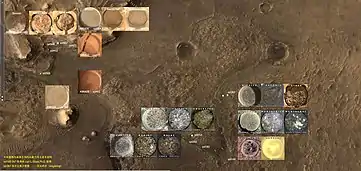

The Mars 2020 mission landed the Perseverance rover in Jezero crater in February 2021. It collected multiple samples and packed them into cylinders for later return. Jezero appears to be an ancient lakebed, suitable for ground sampling.[52][53][54]
In the beginning of August 2021, Perseverance made its first attempt to collect a ground sample by drilling out a finger-size core of Martian rock.[55] This attempt did not succeed. A drill hole was produced, as indicated by instrument readings, and documented by a photograph of the drill hole. However, the sample container turned out to be empty, indicating that the rock sampled was not robust enough to produce a solid core.[56]
A second target rock judged to have a better chance to yield a sufficiently robust sample was sampled at the end of August and the beginning of September 2021. After abrading the rock, cleaning away dust by puffs of pressurized nitrogen, and inspecting the resulting rock surface, a hole was drilled on September 1. A rock sample appeared to be in the tube, but it was not immediately placed in a container. A new procedure of inspecting the tube optically was performed.[57] On September 6, the process was completed and the first sample placed in a container.[58]
List of samples cached
| Sample Details | ||||||||||||
|---|---|---|---|---|---|---|---|---|---|---|---|---|
| Sampling Attempt | Date | Tube No. | Seal No. | Ferrule Prefix[note 1] | Ferrule No. | Contents | Sample Name and Image | Rock Name | Core Length[note 2] | Estimated Martian Atmosphere Headspace Gas[note 3] | Location | Notes |
| 1 | 22 June 2021 (Sol 121) |
SN061 | SN147 | 10464848-7 | SN090[59] | Witness Tube (Empty) | N/A | N/A | N/A | 2.2 x 10−6 mol | North Séítah Unit[60] | This was taken as a dry-run in preparation for later sampling attempts, and did not aim to sample a rock. During final pre-launch activities, this witness tube was activated (the inner seal was punctured to begin accumulation) and placed in the Bit Carousel. This tube will therefore have accumulated contaminants for the entire duration of exposure from a few months before launch through cruise and EDL until it was sealed on the surface of Mars. Given its long exposure, it is likely that the inner surfaces of WB1 will be saturated with organic contaminants, i.e., they will be in adsorption equilibrium with theirimmediate surroundings in the rover (and or the entire spacecraft prior to landing). WB1 is therefore expected to have higher concentrations of contaminants, and potentially different contaminants, than the sample tubes. |
| 2 | 6 August 2021 (Sol 165) |
SN233 | SN025 | 10464848-7 | SN062 | Atmospheric Gas | .jpg.webp) Roubion (failed attempt of caching rock sample) |
Roubion 18.42767°N 77.45167°E |
N/A | 4.9x10−6 mol | Polygon Valley, Cratered Floor Fractured Rough Unit[61] | Attempted to sample the rock but did not succeed, as they didn't reach the bit carousel and the caching system stored and sealed an empty tube. However, in this process, it collected atmospheric samples. |
| 3 | 6 September 2021 (Sol 195) |
SN266 | SN170 | 10464848-6 | SN099[62] | Basalt (or possibly basaltic sandstone) Rock Sample | 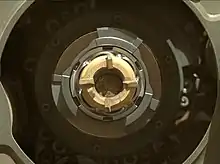 Montdenier |
Rochette 18.43074°N 77.44433°E |
5.98 cm (2.35 in) | 1.2x10−6 mol | Arturby Ridge, Citadelle, South Séítah Unit | Successful sample.[63][64][65] |
| 4 | 8 September 2021 (Sol 197) |
SN267 | SN170 | 10464848-6 | SN074 |
 Montagnac |
6.14 cm (2.42 in) | 1.3x10−6 mol | Sampled from same rock as previous sample. | |||
| 5 | 15 November 2021 (Sol 263) |
SN246 | SN194 | 10464848-5 | SN107[67] | Olivine cumulate Rock Sample | 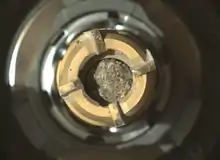 Salette |
Brac 18.43398°N 77.44305°E |
6.28 cm (2.47 in) | 1.1 x10−6 mol | Brac Outcrop, South Séítah Unit | |
| 6 | 24 November 2021 (Sol 272) |
SN284 | SN219 | 10464848-6 | SN189[67] | 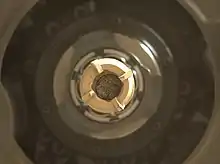 Coulettes |
3.30 cm (1.30 in) | 2.5 x10−6 mol | ||||
| 7 | 22 December 2021 (Sol 299) |
SN206 | SN184 | 10464848-7 | SN064 |  Robine |
Issole 18.43264°N 77.44134°E |
6.08 cm (2.39 in) | 1.0 x10−6 mol | Issole, South Séítah Unit | ||
| 8 | 29 December 2021 (Sol 307) |
SN261 | SN053 | 10464848-6 | SN062 |  Pauls (Abandoned sample from this site due to Core Bit Dropoff.) |
N/A | N/A | Pebble-sized debris from the first sample fell into the bit carousel during transfer of the coring bit, which blocked the successful caching of the sample.[68] It was decided to abandon this sample and do a second sampling attempt again. Subsequent tests and measures cleared remaining samples in tube and debris in caching system[69][70] The tube was reused for second sample attempt, which was successful. | |||
| 9 | 31 January 2022 (Sol 338) |
.jpg.webp) Malay |
3.07 cm (1.21 in) | 2.7 x10−6 mol | ||||||||
| 10 | 7 March 2022 (Sol 372) |
SN262 | SN172 | 10464848-6 | SN129 | Basaltic Andesite Rock Sample |  Ha'ahóni (aka "Hahonih") |
Sid 18.45242°N 77.44386°E |
6.50 cm (2.56 in) | 0.98 x10−6mol | Ch’ał outcrop(100 m (330 ft) east of Octavia E. Butler Landing), Séítah Unit | |
| 11 | 13 March 2022 (Sol 378) |
SN202 | SN168 | no Cachecam images | SN074 |  Atsá (aka "Atsah") |
6.00 cm (2.36 in) | 1.3 x10−6 mol | ||||
| 12 | 7 July 2022 (Sol 491) |
SN188 | 10464848-4 | SN101 | Sedimentary Rock Sample | 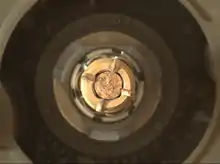 Swift Run |
Skinner Ridge 18.40617°N 77.45893°E |
6.69 cm (2.63 in) | Skinner Ridge, Delta Front | First Deltaic and First sedimentary sample cached by Perseverance. | ||
| 13 | 12 July 2022 (Sol 496) |
SN192 | 10464848-6 | SN068 |  Skyland |
5.85 cm (2.30 in) | ||||||
| 14 | 16 July 2022 (Sol 500) |
SN205 | SN110 | 10464848-6 | SN170 | Witness Tube (Empty) | N/A | N/A | N/A | Hogwallow Flats,[71] Delta Front | This maybe done to clean out any leftover debris during the previous sampling attempts. | |
| 15 | 27 July 2022 (Sol 510) |
SN172 | 10464848-7 | SN099 | Sedimentary Rock Sample | 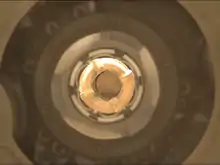 Hazeltop |
Wildcat Ridge 18.40589°N 77.45863°E |
5.97 cm (2.35 in) | Wildcat Ridge, Delta Front | |||
| 16 | 3 August 2022 (Sol 517) |
SN259 | SN177 | 10464848-5 | SN110 |  Bearwallow |
6.24 cm (2.46 in) | |||||
| 17 | 2 October 2022 (Sol 575) |
SN264 | 10464848-5 | SN085 | 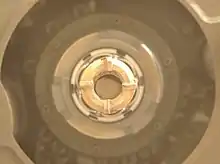 Shuyak |
Amalik outcrop 77.40144°N 18.45073°E |
5.55 cm (2.19 in) | Amalik outcrop, Delta Front | ||||
| 18 | 6 October 2022 (Sol 579) |
SN184 |  Mageik |
There was some undisclosed problem in processing, sealing which was done again on 23 October 2022 (Sol 596) successfully. | ||||||||
| 19 | 14 October 2022 (Sol 586) |
SN188 | SN153 | 10464848-5 | SN073 | Witness Tube (Empty) | 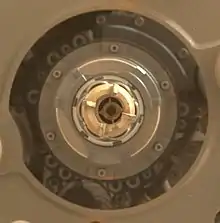 N/A |
N/A | N/A | |||
| Sample Overview | Cached Samples | |||||||||||
|
Samples Tubes Cached (44%) 43
19
|

All Drilled Holes On Mars By Perseverance (except Atsá sample) (Scrollable image)
| |||||||||||
| Sources:[72][73][74][75] | ||||||||||||
NASA–ESA concept
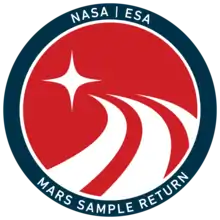
The NASA-ESA plan is to return samples using three missions: a sample collection mission (Perseverance), a sample retrieval mission (Sample Retrieval Lander + Mars ascent vehicle + Sample Transfer arm + 2 Ingenuity class helicopters), and a return mission (Earth Return Orbiter).[76][77][78] The mission hopes to resolve the question of whether Mars once harbored life.
Sample collection
The Mars 2020 mission landed the Perseverance rover, which is storing samples to be returned to Earth later. After consideration, it was decided that given Perseverance's expected longevity, it will be the primary means of transporting samples to Sample Retrieval Lander (SRL).
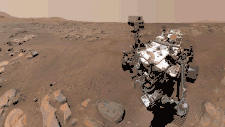
Sample retrieval

(Artwork; 27 July 2022)
The sample retrieval mission involves launching a sample return lander in 2028 with the Mars Ascent Vehicle and two Ingenuity class sample recovery helicopters, both of which will be collecting the samples with a tiny robotic arm as a backup for Perseverance. The rover and helicopters will transport the samples to the SRL lander. SRL's robotic arm will be used to extract the samples and load them into the Sample Return Capsule in the Ascent Vehicle.[76] It is planned to land near the Octavia E. Butler Landing site in 2029.
Mars Ascent Vehicle (MAV)

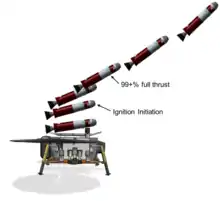
MAV is a 3-meter long, two-stage, solid-fueled rocket that will deliver the collected samples from the surface of Mars to the Earth Return Orbiter. Early in 2022, Lockheed Martin was awarded a contract to partner with NASA's Marshall Space Flight Center in developing the MAV.[80] It is planned to be catapulted into the air just before it ignites, at a rate of 16 feet (5 meters) per second, to remove the odds of wrong liftoff like slipping or tilting of SRL under rocket's shear weight and exhaust at liftoff. This Vertically Ejected Controlled Tip-off Release (VECTOR) system adds a slight rotation during launch, pitching the rocket up and away from the surface.[81] MAV would enter a 380 km orbit.[82] It will remain stowed inside a cylinder on the SRL and will have a thermal protective coating. The rocket's first stage would be run by a single updated STAR-20 engine burning for 70 seconds, while the second stage would have a single updated STAR-15 engine burning for another 27 seconds. They would be separated by a coast phase, after which the sample container would be released in orbit. As of early 2022, the second stage is planned to be spin-stabilized to save weight in lieu of active guidance, while the Mars samples will result in an unknown payload mass distribution.[82]
MAV is scheduled to be launched in 2028 on board the SRL lander.[76]
Earth Return Orbiter (ERO)
ERO is an ESA-developed spacecraft.[83][37] It includes the NASA-built Capture and Containment and Return System to rendezvous with the samples delivered by MAV in low Mars orbit (LMO).
ERO is scheduled to launch on an Ariane 64 rocket[84] in 2027 and arrive at Mars in 2028,[76] using ion propulsion and a separate propulsion element to gradually reach the proper orbit and then rendezvous with the orbiting sample. The MAV's 2nd stage will have a radio beacon that will give controllers the information they need to get the ESA Earth Return Orbiter close enough to the Orbiting Sample to see it through reflective light and capture it for return to earth. The orbiter will retrieve and seal the canisters in orbit and use a NASA-built robotic arm to place the sealed container into an Earth-entry capsule. It will raise its orbit, release the propulsion element, and return to Earth during the 2033 Mars-to-Earth transfer window.
Earth Entry Vehicle (EEV)
The Capture/Containment and Return System (CCRS) would stow the sample in the EEV. EEV would return to Earth and land passively, without a parachute. The desert sand at the Utah Test and Training Range and shock absorbing materials in the vehicle were planned to protect the samples from impact forces.[85][47][37] EEV is scheduled to land on Earth in 2033.[86]
Additional plans
China
China has announced plans for a Mars sample-return mission to be called Tianwen-3.[87] The mission would launch in late 2028, with a lander and ascent vehicle on a Long March 5 and an orbiter and return module launched separately on a Long March 3B. Samples would be returned to Earth in July 2031.[88]
A previous plan would have used a large spacecraft that could carry out all mission phases, including sample collection, ascent, orbital rendezvous, and return flight. This would have required the super-heavy-lift Long March 9 launch vehicle.[89][90][91] Another plan involved using Tianwen-1 to cache the samples for retrieval.[92]
France
France has worked towards a sample return for many years. This included concepts of an extraterrestrial sample curation facility for returned samples, and numerous proposals. They worked on the development of a Mars sample-return orbiter, which would capture and return the samples as part of a joint mission with other countries.[93]
Japan
On 9 June 2015, the Japanese Aerospace Exploration Agency (JAXA) unveiled a plan named Martian Moons Exploration (MMX) to retrieve samples from Phobos or Deimos.[94][95] Phobos's orbit is closer to Mars and its surface may have captured particles blasted from Mars.[96] The launch from Earth is planned for September 2024, with a return to Earth in 2029.[97] Japan has also shown interest in participating in an international Mars sample-return mission.
Russia
A Russian Mars sample-return mission concept is Mars-Grunt.[98][99][100][101][102] It adopted Fobos-Grunt design heritage.[99] 2011 plans envisioned a two-stage architecture with an orbiter and a lander (but no roving capability),[103] with samples gathered from around the lander by a robotic arm.[98][104]
Back contamination
Whether life forms exist on Mars is unresolved. Thus, MSR could potentially transfer viable organisms to Earth, resulting in back contamination — the introduction of extraterrestrial organisms into Earth's biosphere. The scientific consensus is that the potential for large-scale effects, either through pathogenesis or ecological disruption, is small.[105][106][107][108][109] Returned samples would be treated as potentially biohazardous until scientists decide the samples are safe. The goal is that the probability of release of a Mars particle is less than one in a million.[106]
The proposed NASA Mars sample-return mission will not be approved by NASA until the National Environmental Policy Act (NEPA) process has been completed.[110] Furthermore, under the terms of Article VII of the Outer Space Treaty and other legal frameworks, were a release of organisms to occur, the releasing nation(s) would be liable for any resultant damages.[111]
The sample-return mission would be tasked with preventing contact between the Martian environment and the exterior of the sample containers.[106][110]
In order to eliminate the risk of parachute failure, the current plan is to use the thermal protection system to cushion the capsule upon impact (at terminal velocity). The sample container would be designed to withstand the force of impact.[110] To receive the returned samples, NASA proposed a custom Biosafety Level 4 containment facility, the Mars Sample-Return Receiving facility (MSRRF).[112][113]
Other scientists and engineers, notably Robert Zubrin of the Mars Society, argued in the Journal of Cosmology that contamination risk is functionally zero leaving little need to worry. They cite, among other things, lack of any known incident although trillions of kilograms of material have been exchanged between Mars and Earth via meteorite impacts.[114]
The International Committee Against Mars Sample Return (ICAMSR) is an advocacy group led by Barry DiGregorio, that campaigns against a Mars sample-return mission. While ICAMSR acknowledges a low probability for biohazards, it considers the proposed containment measures to be unsafe. ICAMSR advocates more in situ studies on Mars, and preliminary biohazard testing at the International Space Station before the samples are brought to Earth.[115][116] DiGregorio accepts the conspiracy theory of a NASA coverup regarding the discovery of microbial life by the 1976 Viking landers.[117][118] DiGregorio also supports a view that several pathogens – such as common viruses – originate in space and probably caused some mass extinctions and pandemics.[119][120] These claims connecting terrestrial disease and extraterrestrial pathogens have been rejected by the scientific community.[119]
NASA–ESA gallery
- Potential sample-return landing site (14 April 2022)

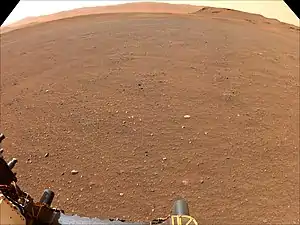

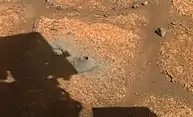
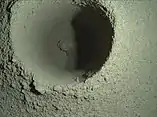
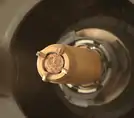
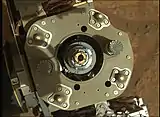

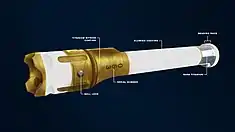



(animated video; 02:22; 6 February 2020)

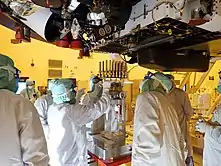
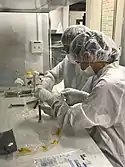
.jpg.webp)
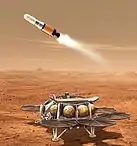
_in_powered_flight_after_release_from_vector.png.webp)
_in_coast_phase_in_Low_Mars_orbit_after_Main_engine_cutoff_awaiting_stage_separation_and_second_engine_startup.jpg.webp)
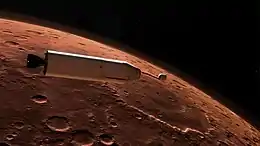
See also
- Timeline of Solar System exploration
References
- Based on CacheCam Images
- measured by volume stations
- measured by volume stations
- Chang, Kenneth (28 July 2020). "Bringing Mars Rocks to Earth: Our Greatest Interplanetary Circus Act – NASA and the European Space Agency plan to toss rocks from one spacecraft to another before the samples finally land on Earth in 2031". The New York Times. Retrieved 28 July 2020.
- "Treiman, et al. – Groundbreaking Sample Return from Mars: The Next Giant Leap in Understanding the Red Planet" (PDF).
- mars.nasa.gov. "Mars Sample Return Campaign". mars.nasa.gov. Retrieved 15 June 2022.
- David, Leonard (23 June 2022). "Controversy Grows Over whether Mars Samples Endanger Earth – Planetary scientists are eager to bring Red Planet rocks, soil and even air to Earth, but critics fear the risk of contaminating our world's biosphere". Scientific American. Retrieved 25 June 2022.
- "NASA's Perseverance Rover Collects First Mars Rock Sample". NASA. 6 September 2021. Retrieved 29 March 2022.
- Mars Sample-Return Archived 2008-05-18 at the Wayback Machine NASA Accessed 2008-05-26
 This article incorporates text from this source, which is in the public domain.
This article incorporates text from this source, which is in the public domain. - e International Mars Architecture for the Return of Samples (iMARS) Working Group (1 June 2008). "Preliminary Planning for an International Mars Sample Return Mission" (PDF). NASA. Retrieved 29 August 2021.
- "Meteoritical Bulletin: Search the Database". lpi.usra.edu. Retrieved 21 August 2020.
- Treiman, A.H. (October 2000). "The SNC meteorites are from Mars". Planetary and Space Science. 48 (12–14): 1213–1230. Bibcode:2000P&SS...48.1213T. doi:10.1016/S0032-0633(00)00105-7.
- Space Studies Board; National Research Council (2011). "Vision and Voyages for Planetary Science in the Decade 2013–2022". National Academies Press. NASA. p. 6‑21.
 This article incorporates text from this source, which is in the public domain.
This article incorporates text from this source, which is in the public domain. - Jones, S.M.; et al. (2008). "Ground Truth From Mars (2008) – Mars Sample Return at 6 Kilometers per Second: Practical, Low Cost, Low Risk, and Ready". Universities Space Research Association (USRA). Retrieved 30 September 2012.
- Harvey, Brian (2007). Russian Planetary Exploration: History, Development, Legacy and Prospects. Springer Science & Business Media. p. 238. ISBN 978-0-387-46343-8.
- “Mars Rover Sample Return Mission Delivery and Return Challenges,” A. Cohen, Director, Johnson Space Center, AIAA 1988-5007, AIAA/NASA First International Symposium on Space Automation and Robotics, 29-30 November 1988.
- “Mars Rover Sample Return: Rover Challenges,” L. Allen, Director, Jet Propulsion Laboratory, AIAA 1988-5009, AIAA/NASA First International Symposium on Space Automation and Robotics, 29-30 November 1988.
- “Advanced Propulsion for the Mars Rover Sample Return Mission,” B. Palaszewski and R. Frisbee, AIAA 1988-2900, AIAA/ASME/SAE/ASEE Joint Propulsion Conference, 11-13 July 1988.
- “Mars Rover Sample Return Ascent, Rendezvous and Return to Earth,” N. Lance, AIAA 1989-0424, 27th Aerospace Sciences Meeting, 9-12 January 1989.
- Shirley, Donna. "Mars Exploration Program Strategy: 1995–2020" (PDF). NASA (JPL). Archived from the original (PDF) on 11 May 2013. Retrieved 18 October 2012.
 This article incorporates text from this source, which is in the public domain.
This article incorporates text from this source, which is in the public domain. - "Groundbreaking Sample-Return from Mars: The Next Giant Leap in Understanding the Red Planet".
- "Mars Program Gears up for Sample Return Mission". NASA.
 This article incorporates text from this source, which is in the public domain.
This article incorporates text from this source, which is in the public domain. - “Mars Sample Return Spacecraft Systems Architecture,” H. Price et al, 2000 IEEE Aerospace Conference, 357.
- Newcott, William (1 August 1998). "Return to Mars". National Geographic Magazine.
- "MarsNews.com: Mars Sample Return". 27 February 2015. Archived from the original on 27 February 2015.
- “Mars Sample Return - Studies for a Fresh Look,” R. Mattingly, S. Matousek and R. Gershman, 2002 IEEE Aerospace Conference, 2-493.
- “Mars Ascent Vehicle - Concept Development,” D. Stephenson, AIAA 2002-4318, 38th AIAA/ASME/SAE/ASEE Joint Propulsion Conference, 7–10 July 2002.
- “Mars Sample Return, Updated to a Groundbreaking Approach,” R. Mattingly, S. Matousek and F. Jordan, 2003 IEEE Aerospace Conference, 2-745.
- “Continuing Evolution of Mars Sample Return,” R. Mattingly, S. Matousek and F. Jordan, 2004 IEEE Aerospace Conference, p. 477.
- “Technology Development Plans for the Mars Sample Return Mission,” R. Mattingly, S. Hayati and G. Udomkesmalee, 2005 IEEE Aerospace Conference.
- “Mars Base Technology Program Overview,” C. Chu, S. Hayati, S Udomkesmalee and D Lavery, AIAA 2005-6744, AIAA Space 2005 Conference, 30 August to September 1, 2005.
- “Mars Ascent Vehicle Key Elements of a Mars Sample Return Mission,” D. Stephenson and H. Willenberg, 2006 IEEE Aerospace Conference paper number 1009.
- "NASA and ESA Establish a Mars Exploration Joint Initiative". NASA. 8 July 2009.
 This article incorporates text from this source, which is in the public domain.
This article incorporates text from this source, which is in the public domain. - Christensen, Phil (April 2010). "Planetary Science Decadal Survey: MSR Lander Mission". JPL. NASA. Retrieved 24 August 2012.
 This article incorporates text from this source, which is in the public domain.
This article incorporates text from this source, which is in the public domain. - "BBC – Science/Nature – Date set for Mars sample mission". 10 July 2008.
- "Mars Sample Return: bridging robotic and human exploration". European Space Agency. 21 July 2008. Retrieved 18 November 2008.
- "International cooperation called key to planet exploration". NBC News. 22 August 2012.
- "EXPLORING OUR SOLAR SYSTEM: THE ASTEROIDS ACT AS A KEY STEP". www.govinfo.gov.
- Wall, Mike (27 September 2012). "Bringing Pieces of Mars to Earth: How NASA Will Do It". Space.com.
- Mattingly, Richard (March 2010). "Mission Concept Study: Planetary Science Decadal Survey – MSR Orbiter Mission (Including Mars Returned Sample Handling)" (PDF). NASA. Archived from the original (PDF) on 29 September 2015.
 This article incorporates text from this source, which is in the public domain.
This article incorporates text from this source, which is in the public domain. - Amos, Jonathan (6 July 2018). "Fetch rover! Robot to retrieve Mars rocks". BBC.
- Leone, Dan (3 October 2012). "Mars Planning Group Endorses Sample Return". SpaceNews. Retrieved 1 March 2022.
- "Summary of the Final Report" (PDF).
- Rincon, Paul (26 April 2018). "Space agencies intent on mission to deliver Mars rocks to Earth". BBC.
- "Video (02:22) – Bringing Mars Back To Earth". NASA. 26 April 2018. Archived from the original on 22 December 2021.
 This article incorporates text from this source, which is in the public domain.
This article incorporates text from this source, which is in the public domain. - Foust, Jeff (28 July 2019). "Mars sample return mission plans begin to take shape". SpaceNews.
- Cowart, Justin (13 August 2019). "NASA, ESA Officials Outline Latest Mars Sample Return Plans". The Planetary Society.
- Clark, Stephen (20 April 2020). "NASA narrows design for rocket to launch samples off of Mars". Spaceflight Now. Retrieved 21 April 2020.
- Foust, Jeff (20 July 2016). "Mars 2020 rover mission to cost more than US$2 billion". SpaceNews.
- Evans, Kim (13 October 2015). "NASA Eyes Sample-Return Capability for Post-2020 Mars Orbiter". Denver Museum of Nature and Science. Archived from the original on 31 August 2017. Retrieved 10 November 2015.
- "Nobody Tell Elmo About Issole". nasa.gov. Retrieved 11 February 2022.
- mars.nasa.gov. "NASA's Perseverance Plans Next Sample Attempt". NASA’s Mars Exploration Program. Retrieved 27 August 2021.
- "Sample Caching Dry Run, 1st sample tube cached". Twitter. Retrieved 27 August 2021.
- mars.nasa.gov. "Perseverance Sample Tube 266". NASA’s Mars Exploration Program. Retrieved 9 September 2021.
- "Welcome to 'Octavia E. Butler Landing'". NASA. 5 March 2021. Retrieved 5 March 2021.
- Voosen, Paul (31 July 2021). "Mars rover's sampling campaign begins". Science. AAAS. 373 (6554): 477. Bibcode:2021Sci...373..477V. doi:10.1126/science.373.6554.477. PMID 34326215. S2CID 236514399. Retrieved 1 August 2021.
- mars.nasa.gov. "On the Eve of Perseverance's First Sample". mars.nasa.gov. Retrieved 12 August 2021.
- Voosem, Paul (21 June 2021). "NASA's Perseverance rover to drill first samples of martian rock". Science. AAAS. Retrieved 1 August 2021.
- mars.nasa.gov. "Assessing Perseverance's First Sample Attempt". mars.nasa.gov. Retrieved 12 August 2021.
- mars.nasa.gov (2 September 2021). "Nasa's perseverance rover successfully cores its first rock". mars.nasa.gov. Retrieved 10 September 2021.
- mars.nasa.gov (6 September 2021). "Nasa's perseverance rover collects first Mars rock sample". mars.nasa.gov. Retrieved 10 September 2021.
- "Sample Caching Dry Run, 1st sample tube cached". Twitter. Retrieved 27 August 2021.
- "Witness Tube in Perseverance Sample Caching System". NASA Jet Propulsion Laboratory (JPL). Retrieved 9 September 2021.
- mars.nasa.gov. "Perseverance's Drive to Citadelle". NASA’s Mars Exploration Program. Retrieved 6 September 2021.
- mars.nasa.gov. "Kicking off the Sampling Sol Path at Citadelle". mars.nasa.gov. Retrieved 6 September 2021.
- Fox, Karen; Johnson, Alana; Agle, AG (2 September 2021). "NASA's Perseverance Rover Successfully Cores Its First Rock". NASA. Retrieved 3 September 2021.
- Chang, Kenneth (3 September 2021). "On Mars, NASA's Perseverance Rover Drilled the Rocks It Came For – After an earlier drilling attempt failed to collect anything, the rover appeared to gather its first sample. But mission managers need to take another look before sealing the tube". The New York Times. Retrieved 3 September 2021.
- Chang, Kenneth (7 September 2021). "NASA's Perseverance Rover Stashes First Mars Rock Sample – The rock, sealed in a tube, is the first of many the robotic explorer will collect to one day send back to Earth for scientists to study". The New York Times. Retrieved 8 September 2021.
- mars.nasa.gov. "A Historic Moment – Perseverance Collects, Seals, and Stores its First Two Rock Samples". mars.nasa.gov. Retrieved 18 December 2021.
- "A rock so nice, I sampled it twice!". Twitter. Retrieved 18 December 2021.
- mars.nasa.gov. "Assessing Perseverance's Seventh Sample Collection". mars.nasa.gov. Retrieved 8 March 2022.
- mars.nasa.gov. "Pebbles Before Mountains". mars.nasa.gov. Retrieved 8 March 2022.
- mars.nasa.gov. "Ejecting Mars' Pebbles". mars.nasa.gov. Retrieved 8 March 2022.
- "Be careful with names. The witness tube was not sampled at 'Skinner Ridge'. Skinner Ridge is the name of the small outcrop the sample cores were taken from. The witness tube was 'processed' at the 'Hogwallow Flats' area". Twitter. August 2022. Retrieved 4 November 2022.
- mars.nasa.gov. "Perseverance Rover Mars Rock Samples". NASA Mars Exploration. Retrieved 15 June 2022.
- "MARS 2020 INITIAL REPORTS Crater Floor Campaign" (PDF).
- "Mars 2020 Returned Sample Science Archive". pds-geosciences.wustl.edu. Retrieved 6 October 2022.
- "I had a list I was working on, combined it with the NASA website chart". Twitter. Retrieved 24 October 2022.
- Foust, Jeff (27 March 2022). "NASA to delay Mars Sample Return, switch to dual-lander approach". SpaceNews. Retrieved 28 March 2022.
- "Future Planetary Exploration: New Mars Sample Return Plan". 8 December 2009.
- "Mars sample return". www.esa.int. Retrieved 3 January 2022.
- Chang, Kenneth (27 July 2022). "NASA Will Send More Helicopters to Mars - Instead of sending another rover to help retrieve rock and dirt samples from the red planet and bring them to Earth, the agency will provide the helicopters as a backup option". The New York Times. Retrieved 28 July 2022.
- "NASA Selects Developer for Rocket to Retrieve First Samples from Mars". NASA Press Release 22-015, Feb 7 2022. 7 February 2022. Retrieved 2 July 2022.
- "NASA Begins Testing Robotics to Bring First Samples Back From Mars". NASA Jet Propulsion Laboratory (JPL). 13 December 2021. Retrieved 2 August 2022.
- Yaghoubi, Darius; Maynor, Shawn. "Integrated Design Results for the MSR SRC Mars Ascent Vehicle" (PDF). NASA Technical Reports Server. Retrieved 26 April 2022.
- "Airbus to bring first Mars samples to Earth: ESA contract award | Airbus". www.airbus.com. 28 October 2021. Retrieved 14 December 2021.
- "Earth Return Orbiter's first step to Mars". Airbus (Press release). 15 June 2021. Retrieved 28 March 2022.
- Kellas, Sotiris (March 2017). "Passive earth entry vehicle landing test". 2017 IEEE Aerospace Conference. Big Sky, MT, USA: IEEE: 1–10. doi:10.1109/AERO.2017.7943744. hdl:2060/20170002221. ISBN 978-1-5090-1613-6. S2CID 24286971.
- Gebhardt, Chris; Barker, Nathan (4 June 2021). "Mars Ascent Vehicle from Northrop Grumman takes shape for Mars Sample Return mission". NASASpaceFlight.com. Retrieved 27 August 2021.
- Andrew Jones published (18 May 2022). "China to launch Tianwen 2 asteroid-sampling mission in 2025". Space.com. Retrieved 20 May 2022.
- Jones, Andrew (20 June 2022). "China aims to bring Mars samples to Earth 2 years before NASA, ESA mission". SpaceNews. Retrieved 21 June 2022.
- Writers Beijing (AFP) (10 October 2012). "China to collect samples from Mars by 2030: Xinhua". marsdaily.com.
- "China Is Racing to Make the 2020 Launch Window to Mars". Chinese Academy of Science.
- Jones, Andrew (19 December 2019). "A closer look at China's audacious Mars sample return plans". The Planetary Society.
- Plans To Land A Rover On Mars In 2020. Alexandra Lozovschi, Inquisitr, 17 January 2019
- Counil, J.; Bonneville, R.; Rocard, F. (1 January 2002). "The french involvement in Mars sample-return program". 34th COSPAR Scientific Assembly. 34: 3166. Bibcode:2002cosp...34E3166C – via NASA ADS.
 This article incorporates text from this source, which is in the public domain.
This article incorporates text from this source, which is in the public domain. - "JAXA plans probe to bring back samples from moons of Mars". The Japan Times Online. 10 June 2015.
- Torishima, Shinya (19 June 2015). "JAXAの「火星の衛星からのサンプル・リターン」計画とは". Mynavi News (in Japanese). Retrieved 6 October 2015.
- "火星衛星の砂回収へ JAXA「フォボス」に探査機". The Nikkei (in Japanese). 22 September 2017. Retrieved 20 July 2018.
- MMX Homepage (English version) JAXA 2017
- Roscosmos – Space missions Published by The Space Review (page 9) on 2010
- Day, Dwayne A. (28 November 2011). "'Red Planet blues (Monday, November 28, 2011)". The Space Review. Retrieved 16 January 2012.
- Kramnik, Ilya (18 April 2012). "Russia takes a two-pronged approach to space exploration". Russia & India Report. Retrieved 18 April 2012.
- Russia To Study Martian Moons Once Again, Mars Daily, July 15, 2008.
- Major provisions of the Russian Federal Space Program for 2006–2015, "1 spacecraft for Mars research and delivery of Martian soil to the Earth"
- Brian Harvey; Olga Zakutnyaya (2011). Russian Space Probes: Scientific Discoveries and Future Missions. Springer Science & Business Media. p. 475. ISBN 978-1-4419-8150-9.
- "ExoMars to pave the way for soil sample return". russianspaceweb.com.
- NASA.gov Preliminary Planning for an International Mars Sample Return Mission Report of the International Mars Architecture for the Return of Samples (iMARS) Working Group June 1, 2008
 This article incorporates text from this source, which is in the public domain.
This article incorporates text from this source, which is in the public domain. - European Science Foundation – Mars Sample Return backward contamination – Strategic advice and requirements Archived 2 June 2016 at the Wayback Machine July 2012, ISBN 978-2-918428-67-1 – see Back Planetary Protection section (for more details of the document see abstract)
 This article incorporates text from this source, which is in the public domain.
This article incorporates text from this source, which is in the public domain. - Joshua Lederberg Parasites Face a Perpetual Dilemma Volume 65, Number 2, 1999/ American Society for Microbiology News 77
 This article incorporates text from this source, which is in the public domain.
This article incorporates text from this source, which is in the public domain. - Assessment of Planetary Protection Requirements for Mars Sample Return Missions (Report). National Research Council. 2009.
- Mars Sample Return: Issues and Recommendations Task Group on Issues in Sample Return, National Academies Press, Washington, D.C. (1997)
 This article incorporates text from this source, which is in the public domain.
This article incorporates text from this source, which is in the public domain. - "Mars Sample Return Discussions As presented on February 23, 2010" (PDF). Archived from the original (PDF) on 16 February 2013. Retrieved 12 August 2013. Mars Sample Return Discussions As presented on February 23, 2010
 This article incorporates text from this source, which is in the public domain.
This article incorporates text from this source, which is in the public domain. - "Treaty on Principles Governing the Activities of States in the Exploration and Use of Outer Space, including the Moon and Other Celestial Bodies". Archived from the original on 8 July 2013. Retrieved 13 July 2013.
- "Mars Sample Return Receiving Facility" (PDF).
- Mars Sample Return Receiving Facility – A Draft Test Protocol for Detecting Possible Biohazards in Martian Samples Returned to Earth (PDF) (Report). 2002.
- Zubrin, Robert (2010). "Human Mars Exploration: The Time Is Now". Journal of Cosmology. 12: 3549–3557. Archived from the original on 20 November 2010.
- "ICAMSR – Planetary Protection". www.icamsr.org.
- DiGregorio, Barry. "The dilemma of Mars sample return". Chemical Innovation. 31 (8): 18–27 – via ACS Publications.
- Life On Mars, Coast To Coast show. Accessed 23 August 2018
- Local scientist has evidence of life on Mars, Mike Randall, ABC News, Buffalo 14 February 2018
- Joseph Patrick Byrne (2008). Encyclopedia of Pestilence, Pandemics, and Plagues. ABC-CLIO. pp. 454–455. ISBN 978-0-313-34102-1.
- Richard Stenger Mars sample return plan carries microbial risk, group warns, CNN, November 7, 2000
- Kahn, Amina (10 February 2020). "NASA gives JPL green light for mission to bring a piece of Mars back to Earth". Los Angeles Times. Retrieved 11 February 2020.
- "Mission to Mars – Mars Sample Return". NASA. 2020. Retrieved 11 February 2020.
 This article incorporates text from this source, which is in the public domain.
This article incorporates text from this source, which is in the public domain.
External links
- Mars Sample return media reel produced by NASA and JPL (video)
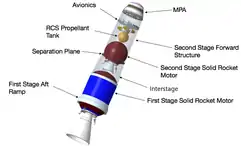

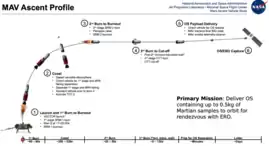
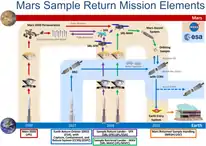
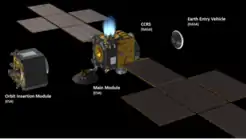

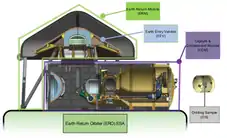
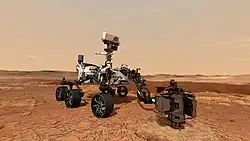


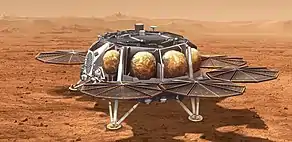

.jpg.webp)

.jpg.webp)
.jpg.webp)